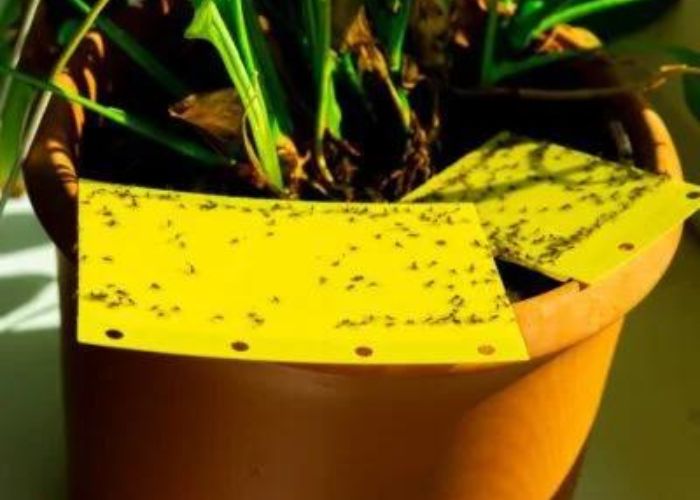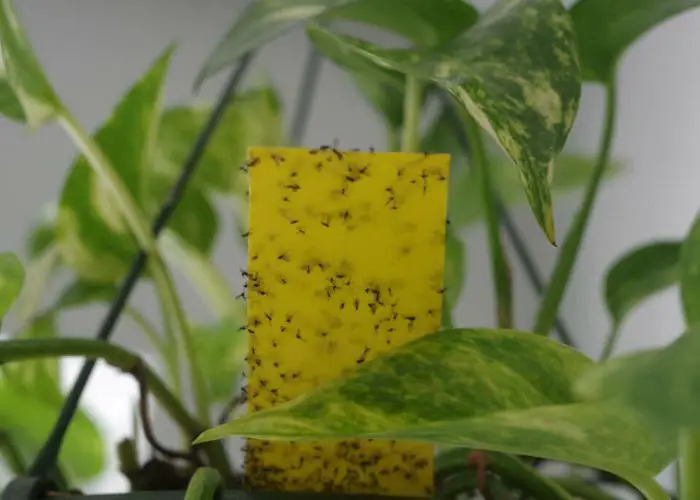Effective yet easy to use, most gardeners are familiar with fungus gnat yellow sticky traps.
As a houseplant enthusiast, knowing how to use fungus gnat yellow sticky trap was a breakthrough for my indoor plants.
The sticky traps capture pests and insects attracted to the color yellow. Placing the traps in your garden will help you control thrips, whiteflies, flea beetles, and fungus gnats.
While you can also use the traps outdoors, you risk catching beneficial insects alongside pests. This post focuses on how to use fungus gnat yellow sticky trap.
How To Use Fungus Gnat Yellow Sticky Trap
Peel off the protective backing from the fungus gnat yellow sticky trap to reveal the adhesive surface. Once the backing is removed, the trap is ready to be hung near your plants to capture any adult fungus gnats. The sticky surface of the trap will attract and trap the adult gnats, preventing them from laying eggs in the soil.
How Do You Use a Sticky Trap for Gnats

Sticky traps for gnats and other flying insects are easy to use. While some traps include reusable metal trap holders, others have a wire for attaching them to plants.
Adhere to the steps below to ensure your yellow trap’s effectiveness against gnats.
- Step 1: Peel off the protective paper from both sides of the sticky trap.
- Step 2: Stick the trap carefully onto the soil using a trap holder. If the trap includes a wire, attach it around the plant, 2 to 3 inches above the plant canopy.
- Step 3: Position the trap such that both sides are accessible. Ensure the sticky surface doesn’t come into contact with the plant’s leaves.
- Step 4: Wait for the effect to take place.
Alternatively, you can place the sticky trap away from your plants to lure the insects away. To achieve the best results, keep the trap around plant height.
Ideally, place one yellow fungus gnat sticky trap per square meter or plant stand. This should be enough to monitor and control pest infestation.
Remember to space out the yellow sticky traps around areas prone to pest infestation.
The traps will remain effective for a long period regardless of the season, eliminating the need to replace them. Most fungus gnat yellow sticky traps last for a minimum of 6 months.
Suppose you’re encountering a severe case of pest infestation; your yellow sticky traps will fill up in no time.
Consider using more traps if this is your case. Also, you’ll need to replace them sooner and more often to maintain their effectiveness.
Do Yellow Sticky Traps Work for Fungus Gnats?
Yes, yellow sticky traps are effective against fungus gnats. They’ll also trap aphids, white flies, thrips, shore flies, and leafminers attacking indoor plants.
Based on the severity of the pest infestation, you can use the entire yellow sticky fungus gnat trap or fragment them into smaller traps. To do this, cut the traps in the traps halfway.
You can also utilize sticky traps all year round, regardless of the season. However, they’ll be more effective when pests become active, probably around the end of March.
How Do Yellow Sticky Traps Work?
Yellow sticky traps consist of cardboard or plastic covered with an adhesive layer. They rely on the instincts of certain insects, luring them toward the trap.
They attract pests that stick to the layer of the adhesive before dying. If you’ve worn a yellow tee shirt outdoors, especially during summer, you’ll notice that the color attracts various insects.
Insects require nectar and pollen to subsist, and yellow flowers provide both in surplus. This biological instinct will have the same attraction effect in yellow sticky traps.
Unlike other methods of dealing with pest infestation, yellow sticky traps don’t require insecticides or pheromones to attract and trap insects.
Their bright color yellow easily draws the attention of pests, attracting them to the looming danger.
However, some manufacturers may use pheromones to enhance their effectiveness or trap specific pests. Including pheromones helps attract many pests with biological attraction to sex hormones.
However, did you know different types of sticky traps exist besides yellow ones? They include blue sticky fly traps, which attract insects that are less attracted to yellow colors.
Yellow Sticky Traps for Pest Infestation Control
Yellow sticky fungus gnat traps are suitable for monitoring pest infestation. In most cases, they help to minimize the number of pests attacking your houseplant.
Some insects which you can trap with yellow sticky traps include;
- Aphidoidea (winged aphids)
- Grape thrips (Thysanoptera)
- Fungus gnats (Sciaridae)
- Drosophila (fruit flies)
- Leaf miners
- Greenhouse white flies
- Green leafhoppers
- Shore flies
Installing yellow sticky traps can help you detect pest infestation in the onset stage. Besides indoor plants, you can utilize the sticky traps in greenhouses and outdoors.
This allows you to tackle the infestation sooner before the situation gets out of hand.
While yellow sticky fly traps aren’t a pest control method in their sense, they can indicate how effective other control measures have been.
We often recommend using yellow sticky traps alongside other pest control methods since some insects might escape the traps and continue to reproduce.
Besides, the insect larvae in the soil pose a greater risk for your houseplant. Unfortunately, yellow fly traps don’t work in the soil.
How Long Does It Take for Yellow Sticky Gnat Traps to Work?
Expect your gnat trap to catch flying bugs within 24 hours. After around 48h, you’ll notice more accumulation on the yellow fly trap.
Leave the sticky trap in place until it traps a lot of bugs or you don’t spot gnats around your plant.
Do Yellow Sticky Traps Endanger Beneficial Insects?
We recommend using yellow sticky traps in indoor gardens only. Since ladybirds, bees, and other useful bugs rarely stray into homes, the risk of trapping them is quite low.
Reconsider placing yellow sticky traps in your outdoor garden. Using them outdoors increases the likelihood of small birds and beneficial insects flying into them.
Yellow sticky traps are among the few effective options to prevent spotted wing drosophila from laying eggs in cherry trees.
When deploying sticky traps in plants on your cherries, please leave them in place between May and June.
It’s vital to remove the sticky traps afterward. This will minimize the number of beneficial insects getting trapped accidentally.
Benefits of Yellow Sticky Gnat Traps
The benefits of fungus gnat yellow sticky trap for indoor gardens include;
- They’re inexpensive
- They’re easy to use
- They’re harmless and non-toxic
- Very effective
Disadvantages of Yellow Sticky Gnat Traps
While yellow sticky fly traps are effective against fungus gnats, they have a few setbacks, including;
- They can accidentally trap and kill beneficial insects and other critters, such as lizards.
- This is often the case when you use these sticky traps outdoors.
- Toddlers and pets can get stuck on sticky traps whenever they poke the plants.
- The bright yellow color stands out, distorting the appeal of your indoor plants.
What is the Fastest Way to Get Rid of Gnats?
The easiest and fastest way to get rid of gnats is by using yellow sticky fly traps. While I love the aesthetic appeal tropical plant house brings to my home, having indoor plants may pause several nuisances.
Indoor plants accumulate dust, thus requiring constant cleaning. Without cleaning the plant’s leaves, you risk attracting bugs, particularly fungus gnats.
Fungus gnats are drawn to rotting fruits, garbage, and soggy potting soil. These tiny flies buzz around plants, giving off a homely aura.
While it’s difficult to eliminate gnats completely, store-bought and homemade sprays will also help control them. However, unlike sticky traps, these pesticides are often toxic.
FAQs
Why do yellow sticky fly traps attract insects?
Yellow sticky traps utilize phototaxis to attract flying insects. Most bugs are naturally attracted to the yellow color, especially in flowers. Yellow sticky traps are effective against leaf miners, aphids, white flies, thrips, midges, and black flies, among other flying plant pests.
How do yellow sticky traps function?
Yellow sticky traps consist of cardboard or plastic covered with an adhesive later. The traps take advantage of the instincts of certain insects, luring them to the glue. Once the insect sticks to the adhesive, they become immobile and die.
How do you use yellow sticky traps for gnats?
Peel off the backer from both sides of the sticky traps. Next, place the trap into the soil using a stake or metal holder. Ensure that both sides of the trap are easily accessible. Moreover, the trap shouldn’t contact the plant’s leaves.
What is the difference between blue and yellow sticky fly traps?
Blue sticky traps are often used for thrips since the color is more attractive to them. However, unlike yellow traps, most insects fail to discern the blue color. Since yellow sticky fly traps attract various insects, they’re more effective in controlling pest infestation.
Related Post: How to get rid of thrips on monstera
Can plants recover from fungus gnats?
Yes, plants can recover from a fungus gnat infestation. If you suspect there are fungus gnat larvae in the soil, spray pesticides directly where adult insects rest. Afterward, allow the soil surface to dry to a 2-inch depth. Reapply the pesticide for three or four weeks until the insects disappear or die. Also, avoid overwatering the soil onward.
Conclusion
Have pests infested your garden? Pests and insects can raid indoor gardens, affecting the health of houseplants.
Before reaching out for toxic pesticides, consider deploying a harmless pest control method.
Knowing how to use fungus gnat yellow sticky traps is vital for your indoor gardening success.
Besides being environmentally friendly, yellow sticky traps are also effective and inexpensive.

